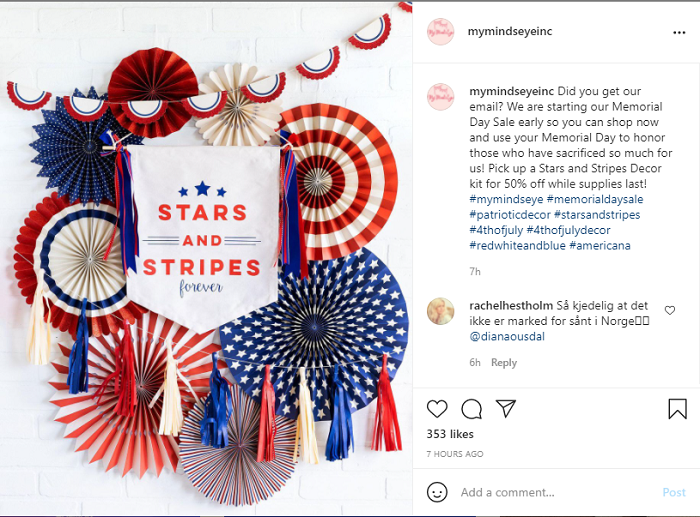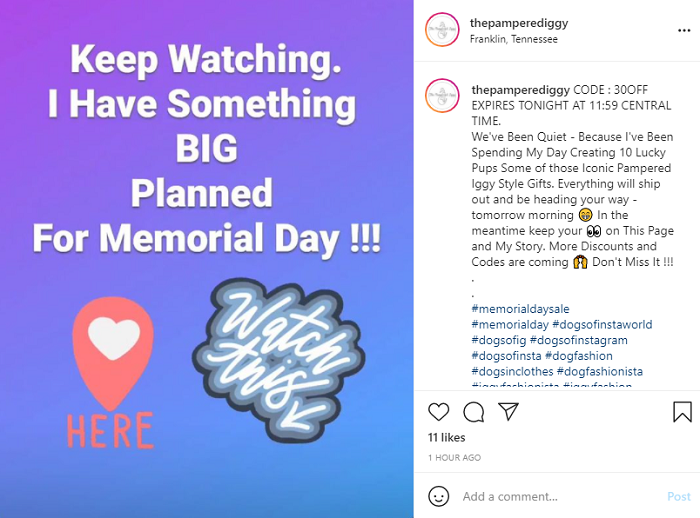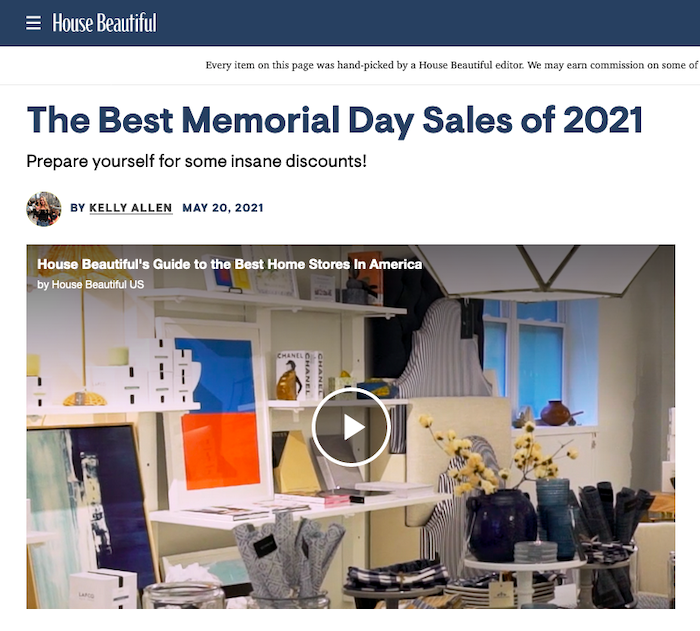MARKETING
7 Strategies for Memorial Day Sales

Memorial Day means many things to many people. At its heart, it’s a day to commemorate the brave American soldiers who died fighting for this country. For many, the Memorial Day weekend also marks the start of summer and a chance to grab a deal in the annual holiday shopping event.
The shopping event is no longer the preserve of brick-and-mortar stores. Research by Namogoo shows e-commerce fashion sales soared over Memorial Day 2020, up 380 percent compared to the year before. Conversions increased by 335 percent, too.
These kinds of figures don’t happen by magic, however. Marketing plays a crucial role in your store’s success.
That’s why I’m going to show seven strategies to send your Memorial Day sales soaring.
7 Tips for E-Commerce Memorial Day Sales
A record-breaking Memorial Day doesn’t happen by luck. By using one or several of the following tips, you give your store a better chance of getting noticed, winning new customers, and having a great weekend.
1. Run a Paid Ad Campaign Showcasing Your Sales
Succeeding over the Memorial Day weekend is all about standing out. Big brands may do this with television commercials or billboards. Smaller brands often stick to social media. I recommend combining the two via a paid ad campaign on social media.
While few brands can afford to go all out on a TV ad, many e-commerce brands can afford a short paid ad campaign, especially if it’s optimized for conversions.
There are two crucial factors you need to get right: The channel you advertise on and the creative you use.
I recommend sticking to Facebook or Google for your paid ads. These platforms offer the greatest reach and the best targeting tools to help make sure your paid media budget goes the furthest.
When it comes to ad creative, it’s all about standing out. Using red, white, and blue, and an American flag are a given. But also consider including summer-related imagery that so many consumers relate to the holiday.
It’s essential to remember that, unlike Independence Day, this is a day of remembrance. Keep your tone respectful of the fallen and their loved ones, even if you’re focusing on summer fun. This ad from My Mind’s Eye does a great job of finding this balance: It’s eye-catching, positive, and still reminds viewers of the reason for the holiday.

Use Memorial Day hashtags on social media platforms, but be careful about the kind of content you post. Some people may be using these hashtags to search for information around the holiday itself and may be offended by overly promotional material.
2. Tease Your Sales on Social Media Without Revealing What They Are Until Memorial Day
Teasing your Memorial Day sales on social media is a fantastic way to drum up anticipation and build a potential customer base well before the big day. By running it on social channels, you have the chance to pick up thousands of new users who have never shopped with you before.
Get your social media calendar in place well ahead of the holiday. The more time you have to post, the more anticipation you can build. This is as true for your email marketing campaign as it is for your social media posts.
For example, The Pampered Iggy—an artist who makes outfits for Italian Greyhounds—teases their upcoming Memorial Day sales in this simple but effective image:

3. Run a Flash Sale
Unlike the winter holiday shopping season, Memorial Day sales last for a couple of days at most. This makes it ripe for flash sales.
These sales typically come with substantial discounts and are all about encouraging consumers to make impulse purchases. They’re also a great way to grab some press attention and make sure customers visit your store over your competitors.
Focusing on your new summer products is the best strategy here. Many consumers wait until Memorial Day weekend to make their spring and summer purchases, so they’re on the lookout for this season’s items. Make the discounts too good to avoid.
Getting the word out about your sales will be just as important. Consider using a paid ad campaign as I described above to promote your sales, but don’t forget about your email list or social media followers.
4. Sell Winter Items at a Deep Discount
Everyone loves a discount, especially on Memorial Day. Price drops between 20 percent and 90 percent are common. There’s no better time to get rid of leftover winter items while attracting new customers than to sell them cheap.
These sales can run alongside your standard Memorial Day sales events, or they can stand on their own. It all depends on what products you stock for summer. Brands that tend to do well during the summer months may prefer to emphasize their new line of products. On the other hand, winter sports stores may just want to make their steep discounts the center of attention.
5. Honor Veterans and Their Families
Memorial Day is a day of remembrance for fallen soldiers. This is why it’s essential to stay positive but not too celebratory about the unofficial start of summer.
Richard Levick, chairman and CEO of LEVICK, says:
Remembrance and relaxation both play important roles in our lives, but they should occupy separate spheres…When brands forget to respect that separation, and when executives who don’t understand the true meaning of Memorial Day are in control of a company’s marketing and social media outreach, insensitive—even offensive—things happen.
In particular, he recommends against potentially exploitative imagery of military funeral services, families in mourning, and so forth. Many companies juxtapose these images with messages of “FLASH SALE!” and “Happy Memorial Day!” which can ruffle feathers.
Not all veterans and families want to hear “thank you for your service” on Memorial Day and want the day focused on those who have been lost. That said, honoring veterans, active duty military, and their families can be done tastefully and well, without drawing focus away from the meaning of the day—chances are many of them have lost someone in the line of duty.
There are many ways you can honor veterans and active service people. One option is to give them early or preferential access to your sale. Another is to offer them discounts or special offers. You could even give away small items as gifts.
But a particularly special thing you can do to show your understanding and gratitude? Donate a portion of your proceeds from your Memorial Day sale to a charity supporting the families of fallen soldiers, like the Tragedy Assistance Program for Survivors (TAPS) or the Children of Fallen Patriots Foundation. Mention this plan in your Memorial Day marketing materials, but keep the focus on those who need the help, not how awesome you are for doing this.
6. Contact Websites Running Sales Roundups to Get Your Store Featured
The Memorial Day weekend is a fantastic source of content for new publications, many of which include roundups of all the best sales. It’s not an accident when brands get included in these roundups. More often than not, it’s the result of a lot of outreach work.

Start by finding publications in your industry that have produced Memorial Day roundups in the past. If they did a roundup last year, there’s a good chance it will be on the editorial calendar this year.
You can also target bigger, broader publications that aren’t necessarily tied to one industry. Here are just a few websites that have created Memorial Day sales roundups in the past:
Next, draft an email to send to each of these publications. Personalize it a bit, but you can keep the bulk of it the same. Highlight what you have on sale over the Memorial Day weekend, the kind of discounts customers should expect, and why your deal is better than your competitors.
7. Set Up a Virtual Event With a Live Sale Segment
You don’t have to have a brick-and-mortar store to run a live sales event.
There are even some pretty significant benefits stores can realize by running virtual sales events. They are way more accessible for one. You’ll be able to accommodate significantly more attendees (which means more customers), and they’ll be able to tune in from anywhere in the world, too.
It will also be much cheaper to run a virtual sales event than an in-person one. Webinar software and a high-quality camera will cost a few hundred bucks at the most. That’s pretty much all you need. It will be much cheaper for customers who don’t have to travel to your store, too, meaning more money to spend on the sale.
You’ll want to make your sales event as fun and inclusive as possible. To this end, make sure to run games and activities and not just showcase your products. You could even run giveaways and competitions to give away some of your newest products for free.
Make sure that you devote a good chunk of time to your sales products, though. The whole point of running this kind of event is to increase sales, so it makes sense to spend at least the latter half of the event modeling your new clothing range or showing your new products in action.
After the pandemic, you may be facing more competition than usual when it comes to online events. It will pay to get the word out early and promote your virtual event as much as possible. Social media, email campaigns, and your website are all great places to start.
Memorial Day Sales FAQ
Facebook, Instagram, and Google are three of the best platforms to run paid ad campaigns on this Memorial Day weekend.
It can last as little as a few hours, but don’t let it go on for longer than the weekend.
You can incorporate both summer and solemnity. Don’t overdo it on the joy, but keep the message positive. Consider donating proceeds to relevant organizations.
Keep your email as short as possible, but try to stand out. State how much consumers can save, what products are on sale, and any other essential details.
Facebook or Zoom are two popular platforms that are relatively inexpensive (if not free) and stable to run events on.
Conclusion: How to Increase Memorial Day Sales
Memorial Day weekend is one of the biggest shopping events on the calendar. You can’t just launch a sale and expect customers to turn up, however, especially if you’re an e-commerce store.
Running ads, making the most of social media, and reaching out to online publications are vital to get the word out. Making sure your sale strikes the right tone with customers will be key to increasing conversions.
But don’t stop there. The best e-commerce stores use the Memorial Day weekend as a jumping-off point and do everything they can to keep holiday sales high after the Memorial Day spike.
Which tactics are you going to use this Memorial Day?
See How My Agency Can Drive Massive Amounts of Traffic to Your Website
- SEO – unlock massive amounts of SEO traffic. See real results.
- Content Marketing – our team creates epic content that will get shared, get links, and attract traffic.
- Paid Media – effective paid strategies with clear ROI.
MARKETING
Ecommerce evolution: Blurring the lines between B2B and B2C

Understanding convergence
B2B and B2C ecommerce are two distinct models of online selling. B2B ecommerce is between businesses, such as wholesalers, distributors, and manufacturers. B2C ecommerce refers to transactions between businesses like retailers and consumer brands, directly to individual shoppers.
However, in recent years, the boundaries between these two models have started to fade. This is known as the convergence between B2B and B2C ecommerce and how they are becoming more similar and integrated.
Source: White Paper: The evolution of the B2B Consumer Buyer (ClientPoint, Jan 2024)
What’s driving this change?
Ever increasing customer expectations
Customers today expect the same level of convenience, speed, and personalization in their B2B transactions as they do in their B2C interactions. B2B buyers are increasingly influenced by their B2C experiences. They want research, compare, and purchase products online, seamlessly transitioning between devices and channels. They also prefer to research and purchase online, using multiple devices and channels.
Forrester, 68% of buyers prefer to research on their own, online . Customers today expect the same level of convenience, speed, and personalization in their B2B transactions as they do in their B2C interactions. B2B buyers are increasingly influenced by their B2C experiences. They want research, compare, and purchase products online, seamlessly transitioning between devices and channels. They also prefer to research and purchase online, using multiple devices and channels
Technology and omnichannel strategies
Technology enables B2B and B2C ecommerce platforms to offer more features and functionalities, such as mobile optimization, chatbots, AI, and augmented reality. Omnichannel strategies allow B2B and B2C ecommerce businesses to provide a seamless and consistent customer experience across different touchpoints, such as websites, social media, email, and physical stores.
However, with every great leap forward comes its own set of challenges. The convergence of B2B and B2C markets means increased competition. Businesses now not only have to compete with their traditional rivals, but also with new entrants and disruptors from different sectors. For example, Amazon Business, a B2B ecommerce platform, has become a major threat to many B2B ecommerce businesses, as it offers a wide range of products, low prices, and fast delivery
“Amazon Business has proven that B2B ecommerce can leverage popular B2C-like functionality” argues Joe Albrecht, CEO / Managing Partner, Xngage. . With features like Subscribe-and-Save (auto-replenishment), one-click buying, and curated assortments by job role or work location, they make it easy for B2B buyers to go to their website and never leave. Plus, with exceptional customer service and promotional incentives like Amazon Business Prime Days, they have created a reinforcing loyalty loop.
And yet, according to Barron’s, Amazon Business is only expected to capture 1.5% of the $5.7 Trillion addressable business market by 2025. If other B2B companies can truly become digital-first organizations, they can compete and win in this fragmented space, too.”
If other B2B companies can truly become digital-first organizations, they can also compete and win in this fragmented space
Joe AlbrechtCEO/Managing Partner, XNGAGE
Increasing complexity
Another challenge is the increased complexity and cost of managing a converging ecommerce business. Businesses have to deal with different customer segments, requirements, and expectations, which may require different strategies, processes, and systems. For instance, B2B ecommerce businesses may have to handle more complex transactions, such as bulk orders, contract negotiations, and invoicing, while B2C ecommerce businesses may have to handle more customer service, returns, and loyalty programs. Moreover, B2B and B2C ecommerce businesses must invest in technology and infrastructure to support their convergence efforts, which may increase their operational and maintenance costs.
How to win
Here are a few ways companies can get ahead of the game:
Adopt B2C-like features in B2B platforms
User-friendly design, easy navigation, product reviews, personalization, recommendations, and ratings can help B2B ecommerce businesses to attract and retain more customers, as well as to increase their conversion and retention rates.
According to McKinsey, ecommerce businesses that offer B2C-like features like personalization can increase their revenues by 15% and reduce their costs by 20%. You can do this through personalization of your website with tools like Product Recommendations that help suggest related products to increase sales.
Focus on personalization and customer experience
B2B and B2C ecommerce businesses need to understand their customers’ needs, preferences, and behaviors, and tailor their offerings and interactions accordingly. Personalization and customer experience can help B2B and B2C ecommerce businesses to increase customer satisfaction, loyalty, and advocacy, as well as to improve their brand reputation and competitive advantage. According to a Salesforce report, 88% of customers say that the experience a company provides is as important as its products or services.
Market based on customer insights
Data and analytics can help B2B and B2C ecommerce businesses to gain insights into their customers, markets, competitors, and performance, and to optimize their strategies and operations accordingly. Data and analytics can also help B2B and B2C ecommerce businesses to identify new opportunities, trends, and innovations, and to anticipate and respond to customer needs and expectations. According to McKinsey, data-driven organizations are 23 times more likely to acquire customers, six times more likely to retain customers, and 19 times more likely to be profitable.
What’s next?
The convergence of B2B and B2C ecommerce is not a temporary phenomenon, but a long-term trend that will continue to shape the future of ecommerce. According to Statista, the global B2B ecommerce market is expected to reach $20.9 trillion by 2027, surpassing the B2C ecommerce market, which is expected to reach $10.5 trillion by 2027. Moreover, the report predicts that the convergence of B2B and B2C ecommerce will create new business models, such as B2B2C, B2A (business to anyone), and C2B (consumer to business).
Therefore, B2B and B2C ecommerce businesses need to prepare for the converging ecommerce landscape and take advantage of the opportunities and challenges it presents. Here are some recommendations for B2B and B2C ecommerce businesses to navigate the converging landscape:
- Conduct a thorough analysis of your customers, competitors, and market, and identify the gaps and opportunities for convergence.
- Develop a clear vision and strategy for convergence, and align your goals, objectives, and metrics with it.
- Invest in technology and infrastructure that can support your convergence efforts, such as cloud, mobile, AI, and omnichannel platforms.
- Implement B2C-like features in your B2B platforms, and vice versa, to enhance your customer experience and satisfaction.
- Personalize your offerings and interactions with your customers, and provide them with relevant and valuable content and solutions.
- Leverage data and analytics to optimize your performance and decision making, and to innovate and differentiate your business.
- Collaborate and partner with other B2B and B2C ecommerce businesses, as well as with other stakeholders, such as suppliers, distributors, and customers, to create value and synergy.
- Monitor and evaluate your convergence efforts, and adapt and improve them as needed.
By following these recommendations, B2B and B2C ecommerce businesses can bridge the gap between their models and create a more integrated and seamless ecommerce experience for their customers and themselves.
MARKETING
Streamlining Processes for Increased Efficiency and Results

How can businesses succeed nowadays when technology rules? With competition getting tougher and customers changing their preferences often, it’s a challenge. But using marketing automation can help make things easier and get better results. And in the future, it’s going to be even more important for all kinds of businesses.
So, let’s discuss how businesses can leverage marketing automation to stay ahead and thrive.
Benefits of automation marketing automation to boost your efforts
First, let’s explore the benefits of marketing automation to supercharge your efforts:
Marketing automation simplifies repetitive tasks, saving time and effort.
With automated workflows, processes become more efficient, leading to better productivity. For instance, automation not only streamlines tasks like email campaigns but also optimizes website speed, ensuring a seamless user experience. A faster website not only enhances customer satisfaction but also positively impacts search engine rankings, driving more organic traffic and ultimately boosting conversions.
Automation allows for precise targeting, reaching the right audience with personalized messages.
With automated workflows, processes become more efficient, leading to better productivity. A great example of automated workflow is Pipedrive & WhatsApp Integration in which an automated welcome message pops up on their WhatsApp
within seconds once a potential customer expresses interest in your business.
Increases ROI
By optimizing campaigns and reducing manual labor, automation can significantly improve return on investment.
Leveraging automation enables businesses to scale their marketing efforts effectively, driving growth and success. Additionally, incorporating lead scoring into automated marketing processes can streamline the identification of high-potential prospects, further optimizing resource allocation and maximizing conversion rates.
Harnessing the power of marketing automation can revolutionize your marketing strategy, leading to increased efficiency, higher returns, and sustainable growth in today’s competitive market. So, why wait? Start automating your marketing efforts today and propel your business to new heights, moreover if you have just learned ways on how to create an online business
How marketing automation can simplify operations and increase efficiency
Understanding the Change
Marketing automation has evolved significantly over time, from basic email marketing campaigns to sophisticated platforms that can manage entire marketing strategies. This progress has been fueled by advances in technology, particularly artificial intelligence (AI) and machine learning, making automation smarter and more adaptable.
One of the main reasons for this shift is the vast amount of data available to marketers today. From understanding customer demographics to analyzing behavior, the sheer volume of data is staggering. Marketing automation platforms use this data to create highly personalized and targeted campaigns, allowing businesses to connect with their audience on a deeper level.
The Emergence of AI-Powered Automation
In the future, AI-powered automation will play an even bigger role in marketing strategies. AI algorithms can analyze huge amounts of data in real-time, helping marketers identify trends, predict consumer behavior, and optimize campaigns as they go. This agility and responsiveness are crucial in today’s fast-moving digital world, where opportunities come and go in the blink of an eye. For example, we’re witnessing the rise of AI-based tools from AI website builders, to AI logo generators and even more, showing that we’re competing with time and efficiency.
Combining AI-powered automation with WordPress management services streamlines marketing efforts, enabling quick adaptation to changing trends and efficient management of online presence.
Moreover, AI can take care of routine tasks like content creation, scheduling, and testing, giving marketers more time to focus on strategic activities. By automating these repetitive tasks, businesses can work more efficiently, leading to better outcomes. AI can create social media ads tailored to specific demographics and preferences, ensuring that the content resonates with the target audience. With the help of an AI ad maker tool, businesses can efficiently produce high-quality advertisements that drive engagement and conversions across various social media platforms.
Personalization on a Large Scale
Personalization has always been important in marketing, and automation is making it possible on a larger scale. By using AI and machine learning, marketers can create tailored experiences for each customer based on their preferences, behaviors, and past interactions with the brand.
This level of personalization not only boosts customer satisfaction but also increases engagement and loyalty. When consumers feel understood and valued, they are more likely to become loyal customers and brand advocates. As automation technology continues to evolve, we can expect personalization to become even more advanced, enabling businesses to forge deeper connections with their audience. As your company has tiny homes for sale California, personalized experiences will ensure each customer finds their perfect fit, fostering lasting connections.
Integration Across Channels
Another trend shaping the future of marketing automation is the integration of multiple channels into a cohesive strategy. Today’s consumers interact with brands across various touchpoints, from social media and email to websites and mobile apps. Marketing automation platforms that can seamlessly integrate these channels and deliver consistent messaging will have a competitive edge. When creating a comparison website it’s important to ensure that the platform effectively aggregates data from diverse sources and presents it in a user-friendly manner, empowering consumers to make informed decisions.
Omni-channel integration not only betters the customer experience but also provides marketers with a comprehensive view of the customer journey. By tracking interactions across channels, businesses can gain valuable insights into how consumers engage with their brand, allowing them to refine their marketing strategies for maximum impact. Lastly, integrating SEO services into omni-channel strategies boosts visibility and helps businesses better understand and engage with their customers across different platforms.
The Human Element
While automation offers many benefits, it’s crucial not to overlook the human aspect of marketing. Despite advances in AI and machine learning, there are still elements of marketing that require human creativity, empathy, and strategic thinking.
Successful marketing automation strikes a balance between technology and human expertise. By using automation to handle routine tasks and data analysis, marketers can focus on what they do best – storytelling, building relationships, and driving innovation.
Conclusion
The future of marketing automation looks promising, offering improved efficiency and results for businesses of all sizes.
As AI continues to advance and consumer expectations change, automation will play an increasingly vital role in keeping businesses competitive.
By embracing automation technologies, marketers can simplify processes, deliver more personalized experiences, and ultimately, achieve their business goals more effectively than ever before.
MARKETING
Will Google Buy HubSpot? | Content Marketing Institute

Google + HubSpot. Is it a thing?
This week, a flurry of news came down about Google’s consideration of purchasing HubSpot.
The prospect dismayed some. It delighted others.
But is it likely? Is it even possible? What would it mean for marketers? What does the consideration even mean for marketers?
Well, we asked CMI’s chief strategy advisor, Robert Rose, for his take. Watch this video or read on:
Why Alphabet may want HubSpot
Alphabet, the parent company of Google, apparently is contemplating the acquisition of inbound marketing giant HubSpot.
The potential price could be in the range of $30 billion to $40 billion. That would make Alphabet’s largest acquisition by far. The current deal holding that title happened in 2011 when it acquired Motorola Mobility for more than $12 billion. It later sold it to Lenovo for less than $3 billion.
If the HubSpot deal happens, it would not be in character with what the classic evil villain has been doing for the past 20 years.
At first glance, you might think the deal would make no sense. Why would Google want to spend three times as much as it’s ever spent to get into the inbound marketing — the CRM and marketing automation business?
At a second glance, it makes a ton of sense.
I don’t know if you’ve noticed, but I and others at CMI spend a lot of time discussing privacy, owned media, and the deprecation of the third-party cookie. I just talked about it two weeks ago. It’s really happening.
All that oxygen being sucked out of the ad tech space presents a compelling case that Alphabet should diversify from third-party data and classic surveillance-based marketing.
Yes, this potential acquisition is about data. HubSpot would give Alphabet the keys to the kingdom of 205,000 business customers — and their customers’ data that almost certainly numbers in the tens of millions. Alphabet would also gain access to the content, marketing, and sales information those customers consumed.
Conversely, the deal would provide an immediate tip of the spear for HubSpot clients to create more targeted programs in the Alphabet ecosystem and upload their data to drive even more personalized experiences on their own properties and connect them to the Google Workspace infrastructure.
When you add in the idea of Gemini, you can start to see how Google might monetize its generative AI tool beyond figuring out how to use it on ads on search results pages.
What acquisition could mean for HubSpot customers
I may be stretching here but imagine this world. As a Hubspoogle customer, you can access an interface that prioritizes your owned media data (e.g., your website, your e-commerce catalog, blog) when Google’s Gemini answers a question).
Recent reports also say Google may put up a paywall around the new premium features of its artificial intelligence-powered Search Generative Experience. Imagine this as the new gating for marketing. In other words, users can subscribe to Google’s AI for free, but Hubspoogle customers can access that data and use it to create targeted offers.
The acquisition of HubSpot would immediately make Google Workspace a more robust competitor to Microsoft 365 Office for small- and medium-sized businesses as they would receive the ADDED capability of inbound marketing.
But in the world of rented land where Google is the landlord, the government will take notice of the acquisition. But — and it’s a big but, I cannot lie (yes, I just did that). The big but is whether this acquisition dance can happen without going afoul of regulatory issues.
Some analysts say it should be no problem. Others say, “Yeah, it wouldn’t go.” Either way, would anybody touch it in an election year? That’s a whole other story.
What marketers should realize
So, what’s my takeaway?
It’s a remote chance that Google will jump on this hard, but stranger things have happened. It would be an exciting disruption in the market.
The sure bet is this. The acquisition conversation — as if you needed more data points — says getting good at owned media to attract and build audiences and using that first-party data to provide better communication and collaboration with your customers are a must.
It’s just a matter of time until Google makes a move. They might just be testing the waters now, but they will move here. But no matter what they do, if you have your customer data house in order, you’ll be primed for success.
HANDPICKED RELATED CONTENT:
Cover image by Joseph Kalinowski/Content Marketing Institute
-

 SEO6 days ago
SEO6 days agoGoogle Limits News Links In California Over Proposed ‘Link Tax’ Law
-

 SEARCHENGINES6 days ago
SEARCHENGINES6 days agoGoogle Core Update Volatility, Helpful Content Update Gone, Dangerous Google Search Results & Google Ads Confusion
-
SEARCHENGINES7 days ago
Daily Search Forum Recap: April 12, 2024
-

 SEO6 days ago
SEO6 days ago10 Paid Search & PPC Planning Best Practices
-

 MARKETING6 days ago
MARKETING6 days ago2 Ways to Take Back the Power in Your Business: Part 2
-

 SEARCHENGINES5 days ago
SEARCHENGINES5 days agoWeekend Google Core Ranking Volatility
-

 MARKETING4 days ago
MARKETING4 days ago5 Psychological Tactics to Write Better Emails
-

 PPC6 days ago
PPC6 days agoCritical Display Error in Brand Safety Metrics On Twitter/X Corrected












